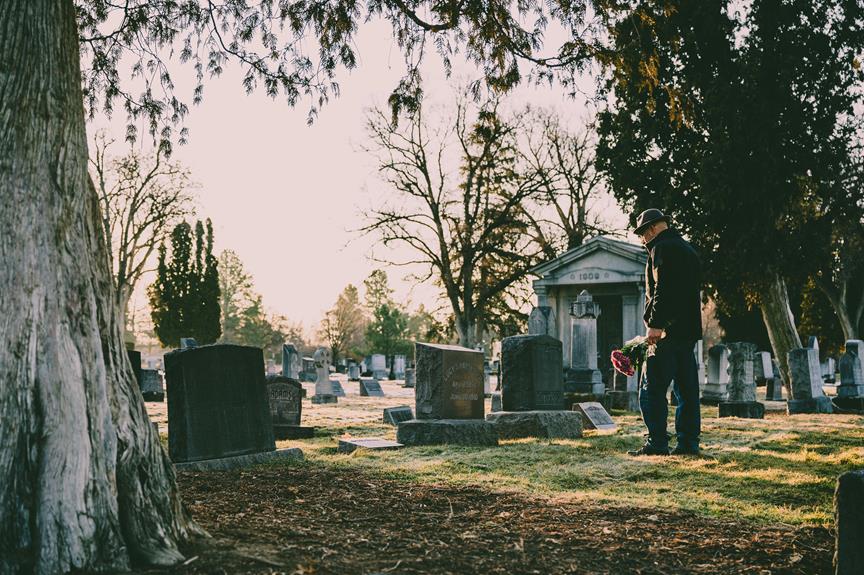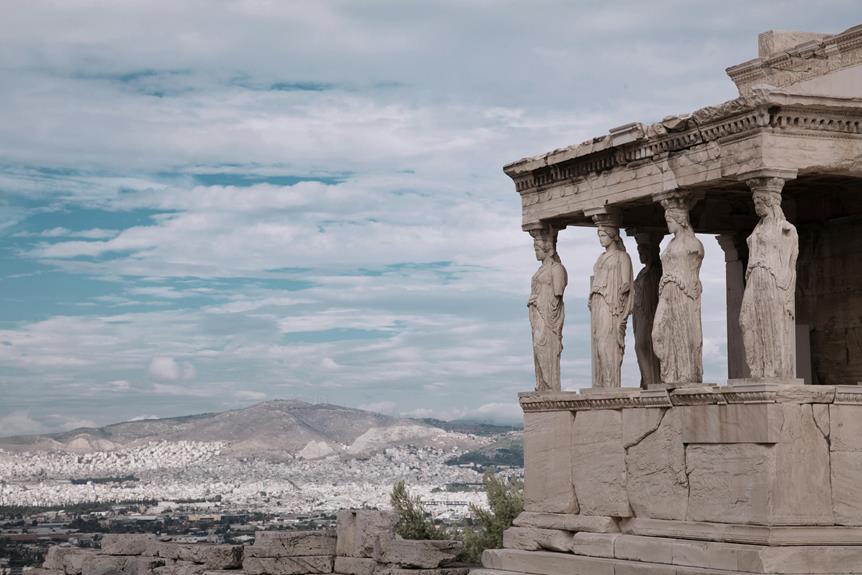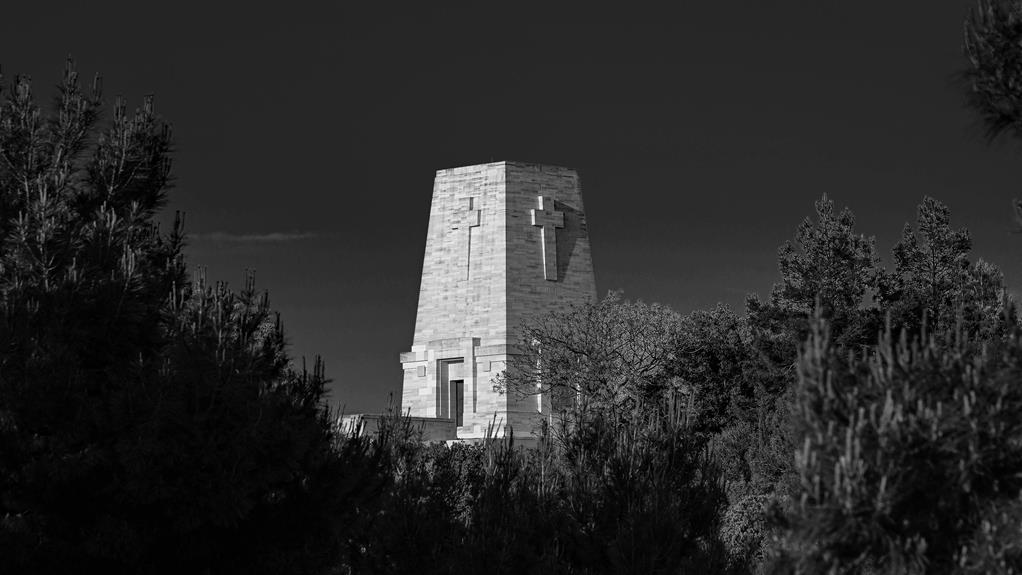Ground Zero, the 9/11 Memorial in the USA, embodies a profound sense of remembrance and reverence for the lives lost during the tragic events of September 11. The memorial's intricate design and symbolic elements create a space for contemplation and reflection, inviting visitors to connect with the collective memory of the past. As one navigates through the site, the stories of resilience and tribute unfold, painting a picture of strength in the face of adversity. This memorial stands as a testament to the enduring spirit of unity and serves as a poignant reminder of the power of honoring history.
Key Takeaways
- Ground Zero's history post-9/11, honoring victims through construction.
- Memorial design with reflecting pools, Survivor Tree, and symbolic bronze parapets.
- Names of victims and first responders inscribed, fostering closure and remembrance.
- Emotional impact on visitors, offering healing and reflection spaces.
- Importance of remembering 9/11 for national unity and honoring heroes.
History of Ground Zero
In the aftermath of the devastating terrorist attacks on September 11, 2001, the history of Ground Zero began to take shape as a solemn symbol of remembrance and resilience. The construction timeline of the site was fraught with challenges, as the need to honor the victims while rebuilding an essential part of New York City tested the resolve of all involved. The initial focus was on clearing the debris and beginning the process of designing a memorial that would pay tribute to the lives lost.
However, the journey towards creating a fitting memorial was not without its controversies. Various stakeholders, including families of the victims, city officials, and architects, had differing visions of how best to commemorate the tragedy. Debates arose over the design, scale, and even the inclusion of certain artifacts, highlighting the delicate balance between preserving history and promoting healing.
Despite these challenges, the memorial at Ground Zero stands today as a symbol of the strength and unity of the American people. It serves as a place of reflection, honoring the nearly 3,000 individuals who perished that fateful day. The history of Ground Zero is a reminder of the resilience that emerged from tragedy and the ongoing commitment to never forget.
Construction of the Memorial
The construction of the memorial at Ground Zero was a vital and testamentary effort involving architects, engineers, and various stakeholders with a shared commitment to honoring the memory of the victims of 9/11. The architectural significance of the memorial is profound, symbolizing resilience and remembrance. The design elements were carefully selected to evoke emotions and provide a space for reflection.
However, constructing the memorial was not without its challenges. The site's complex history and the need to balance honoring the past with creating a hopeful future presented unique obstacles. Engineers had to navigate underground infrastructure, including the PATH train system, while ensuring the structural integrity of the memorial.
Community involvement played an important role in the construction process. Local residents, survivors, and families of victims actively participated in planning and decision-making, ensuring the memorial truly reflected the collective memory and spirit of the community. Fundraising efforts were also significant, with donations pouring in from across the nation to support the construction and maintenance of the memorial.
Despite the difficulties, the memorial at Ground Zero stands as a testament to the resilience of the human spirit and the power of unity in the face of tragedy.
Symbolism and Design
With a profound blend of architectural symbolism and meticulous design elements, the Ground Zero memorial stands as a poignant tribute to the resilience and memory of those impacted by the events of 9/11. The memorial's design, created by Michael Arad and Peter Walker, features two reflecting pools set within the footprints of the Twin Towers. These pools symbolize loss, absence, and the idea of looking into the past. The waterfalls cascading down the sides evoke a sense of renewal and hope, while the surrounding bronze parapets are inscribed with the names of the nearly 3,000 victims.
The architectural symbolism extends to the Survivor Tree, a callery pear tree discovered amidst the rubble, nursed back to health, and replanted at the memorial site. This tree represents resilience, survival, and rebirth. The overall layout of the memorial, with its open plaza and tree-filled green spaces, provides a place for reflection and contemplation, inviting visitors to remember, honor, and pay tribute to the lives lost.
The integration of symbolism and architecture in the Ground Zero memorial creates a space that not only commemorates the past but also looks towards the future with resilience and hope. It serves as a powerful reminder of the unity and strength that emerged from the tragedy of 9/11.
Names Memorialized
Etched within the bronze parapets surrounding the reflecting pools at the Ground Zero memorial are the names of nearly 3,000 victims of the 9/11 attacks, each inscription a solemn tribute to those whose lives were lost on that fateful day.
- Victims' Families: For the families of the victims, seeing their loved ones' names memorialized at Ground Zero can bring a sense of closure and remembrance. The memorial provides a significant space for families to honor and remember their lost family members, fostering healing and peace.
- First Responders: The names of the first responders who bravely rushed into danger on September 11, 2001, are also inscribed at the memorial. These courageous individuals sacrificed their lives to save others, and their names serve as a representation of their heroism and selflessness.
- Healing Process and Community Support: The act of memorializing the victims' names plays an important role in the healing process for survivors, victims' families, and the broader community. It serves as a reminder of the resilience and unity that emerged in the face of tragedy, fostering a sense of community support and solidarity among all those affected by the events of 9/11.
Survivor Tree Story
A symbol of resilience and hope amidst the devastation of 9/11, the Survivor Tree at Ground Zero stands as a living proof to the strength and renewal of the human spirit. The Survivor Tree, a Callery pear tree, was discovered severely damaged in the rubble of the World Trade Center following the attacks on September 11, 2001. Despite the destruction surrounding it, the tree managed to survive, representing the resilience of not only the tree itself but also of the nation as a whole.
After its discovery, the Survivor Tree was nurtured and rehabilitated for several years before being returned to the 9/11 Memorial in 2010. The tree, now thriving, serves as a poignant reminder of the importance of resilience and growth in the face of adversity. Its branches reach towards the sky, symbolizing hope and strength in the aftermath of tragedy.
Visitors to the 9/11 Memorial often pause to reflect upon the Survivor Tree, finding inspiration in its ability to withstand the unimaginable. The tree's story serves as a tribute to the human spirit's capacity for renewal and perseverance, a living reminder of the resilience that continues to define Ground Zero and the United States as a whole.
9/11 Museum Exhibits
Among the various elements that make up the poignant memorial at Ground Zero, the museum exhibits stand as powerful evidence to the events of September 11, 2001. The museum exhibits offer visitors a profound insight into the tragic events of 9/11 through a range of interactive displays and educational resources. Here are three key features of the museum exhibits:
- Interactive Displays: The museum showcases a variety of interactive displays that allow visitors to engage with the history of 9/11 in a more immersive way. Through touchscreens, audiovisual presentations, and virtual reality experiences, visitors can explore the timeline of the attacks, learn about the lives of the victims, and understand the impact of that fateful day.
- Educational Resources: The museum offers a wealth of educational resources for visitors of all ages. From guided tours led by knowledgeable docents to educational programs designed for school groups, the museum aims to provide a detailed understanding of the events of 9/11 and their lasting effects on the world.
- Artifact Exhibits: In addition to interactive displays and educational resources, the museum exhibits a vast collection of artifacts recovered from Ground Zero. These artifacts, ranging from twisted metal beams to personal belongings of the victims, serve as tangible reminders of the human cost of the attacks and help visitors connect on a deeper level with the events of 9/11.
Tribute in Light Installation
The Tribute in Light Installation, situated near the 9/11 Memorial at Ground Zero in the USA, symbolizes a solemn and powerful commemoration of the tragic events of September 11, 2001. This iconic installation consists of two beams of light that reach up to four miles into the sky, mirroring the shape and orientation of the Twin Towers that once stood tall at the World Trade Center. The beams of light, a poignant artistic expression, serve as a beacon of remembrance, piercing the night sky annually on the anniversary of 9/11.
The Tribute in Light Installation plays an essential role in the healing process for many individuals affected by the events of 9/11. By illuminating the skyline of Lower Manhattan, this installation fosters a sense of community solidarity, bringing together people from all walks of life to reflect on the profound impact of the attacks. The gentle glow of the lights provides a moment of solace and reflection, allowing visitors to pay their respects to the victims and heroes of 9/11.
In essence, the Tribute in Light Installation stands as a symbol of resilience, hope, and unity, embodying the unwavering spirit of the American people in the face of adversity. This solemn tribute continues to serve as a reminder of the importance of remembrance and the enduring strength of the human spirit in times of tragedy.
Visiting Ground Zero
Exploring the somber grounds of Ground Zero provides visitors with a profound opportunity to pay their respects and reflect on the impact of the September 11, 2001, attacks. The memorial experience at Ground Zero is a poignant reminder of the lives lost and the resilience of the human spirit in the face of tragedy. As visitors navigate this sacred site, they are encouraged to engage in personal reflections and honor the memories of those who perished on that fateful day.
- Reflecting at the Survivor Tree: The Survivor Tree, a Callery pear tree discovered amidst the rubble of the World Trade Center, symbolizes resilience, survival, and rebirth. Visitors often pause at this tree to reflect on the strength and hope it represents in the midst of devastation.
- Visiting the Reflecting Absence: The two memorial pools, known as the Reflecting Absence, mark the footprints of the original Twin Towers. These pools, with water cascading down their sides and disappearing into a void, evoke a sense of loss and remembrance, inviting visitors to contemplate the enormity of the tragedy.
- Exploring the Memorial Glade: The Memorial Glade, dedicated to the survivors and responders who faced immense challenges in the aftermath of the attacks, serves as a place for quiet contemplation and gratitude for the heroic actions taken on that day. This serene space allows visitors to connect with the bravery and sacrifice displayed during the rescue and recovery efforts.
Emotional Impact on Visitors
Visitors to Ground Zero are profoundly moved by the emotional weight of the memorial, reflecting on the profound impact of the September 11, 2001, attacks as they pay their respects at the solemn site. The memorial serves as a place for healing, where individuals can process their grief and honor the memories of the nearly 3,000 innocent lives lost. The emotional impact on visitors is palpable, with many experiencing a range of feelings from sadness and disbelief to solidarity and resilience.
To further comprehend the emotional impact on visitors, it is essential to contemplate the role of community support in this healing process. The sense of togetherness and shared mourning experienced at Ground Zero fosters a deep connection among visitors, creating a supportive environment for individuals to navigate their emotions. The memorial not only honors the victims but also provides a space for visitors to find solace in the company of others who share their grief.
| Emotional Impact on Visitors | Community Support |
|---|---|
| Visitors reflect on the profound impact of 9/11 | Ground Zero fosters a sense of togetherness |
| Range of emotions experienced: sadness, solidarity | Shared mourning experience |
| Memorial serves as a place for healing | Supportive environment for processing grief |
| Visitors honor the memories of the lives lost | Space for finding solace in shared grief |
Importance of Remembering
Amidst the somber ambiance of Ground Zero, it becomes evident that commemorating the events of September 11th holds significant historical and societal importance. The impactful remembrance of the tragic events that unfolded on that fateful day serves as a vital reminder of the resilience and unity that emerged from the ashes of destruction.
- Preserving History: Remembering 9/11 guarantees that future generations understand the gravity of the terrorist attacks and the lives lost, safeguarding the memory of those who perished in the tragedy.
- Promoting National Unity: Reflecting on the events of 9/11 fosters a sense of national unity, reminding Americans of the strength that arises when facing adversity together.
- Honoring Heroes: Commemorating 9/11 is a way to honor the first responders, civilians, and all those who selflessly risked their lives to help others, showcasing the bravery and compassion that emerged during the crisis.
Frequently Asked Questions
Is There a Specific Time When the Tribute in Light Installation Is Illuminated?
The tribute in light installation is illuminated during specific times as per the lighting schedule set by the organizers. This event holds historical significance and symbolism, representing remembrance and unity.
The timing of the illumination is carefully chosen to honor the memory of a significant event or to mark a special occasion. Attendees can witness this powerful visual display during the designated times, paying homage to the event being commemorated.
How Are New Names Added to the Names Memorialized Section?
When looking at the process of how new names are added to a memorial, it involves a meticulous procedure of submission, review, and approval.
Each name undergoes a thorough evaluation to guarantee its rightful recognition within the memorialized section.
The timeline for this process can vary depending on factors such as verification and validation.
Ultimately, the addition of new names serves as a poignant tribute, honoring individuals with the respect and dignity they deserve.
Can Visitors Leave Tributes or Memorabilia at the Site?
Visitors to memorials often seek ways to pay respects, but it is crucial to understand memorial etiquette.
While many places allow for the leaving of tributes or memorabilia, it is vital to follow guidelines set by the memorial site.
Some locations have specific protocols for collecting keepsakes, ensuring that the integrity of the memorial is maintained while honoring those being remembered.
Understanding and respecting these guidelines helps maintain the sanctity of the memorial space.
Are There Guided Tours Available at Ground Zero?
Guided tours offer visitors the opportunity to gain deeper insights into the site's historical context and memorial significance. These tours provide a structured and informative experience, allowing participants to learn about the personal reflections of those affected by the events.
Tour options may vary, offering different perspectives on the site's significance and ensuring that visitors have a well-rounded understanding of its importance.
What Measures Are in Place to Ensure the Safety of Visitors at the Site?
Ensuring the safety of visitors at a site involves implementing robust security measures to mitigate potential risks and create a secure environment for all individuals. These measures can include:
- Surveillance systems
- Security personnel
- Emergency response protocols
- Regular safety inspections to maintain a high standard of safety
Conclusion
To sum up, the Ground Zero Memorial in the USA stands as a poignant tribute to the victims of the September 11 attacks. The memorial's design and symbolism embody resilience and remembrance, serving as a solemn reminder of the tragedy that unfolded on that fateful day.
Just as the Survivor Tree stands tall amidst the memorial, so too do the memories of those lost, forever etched in the hearts of visitors who pay their respects at the site.


